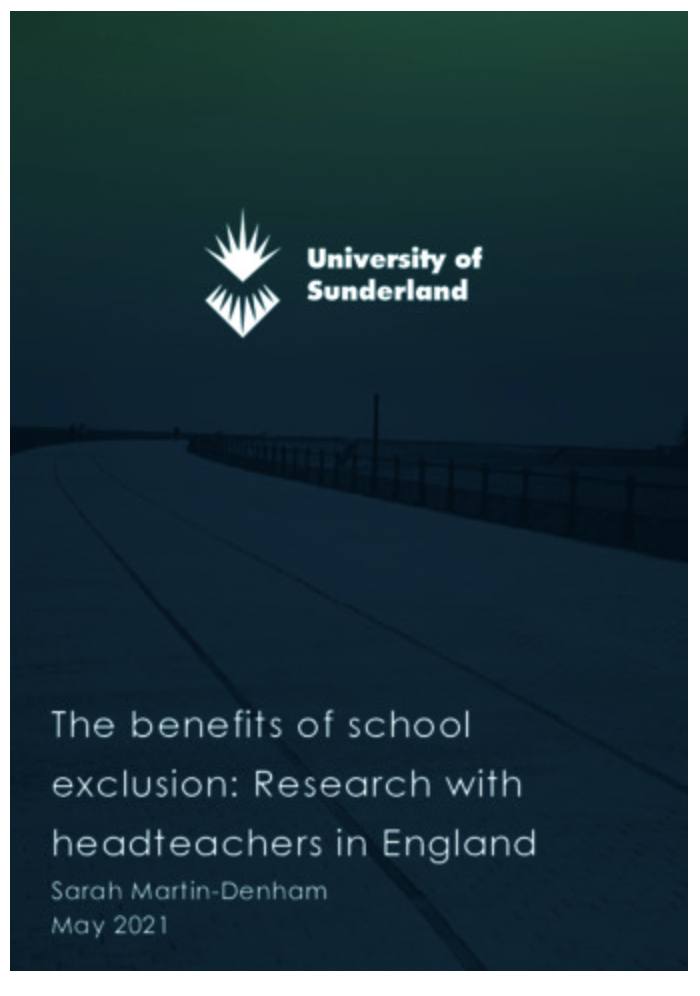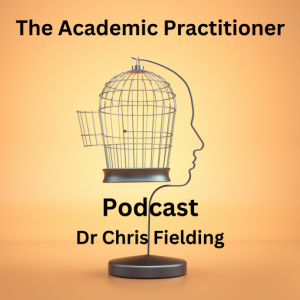This month I am taking a closer look at Sarah Martin-Denham’s 2021 policy brief 1 for the University of Sunderland. It looks at the question of whether headteachers see any benefits to school exclusion. I am very much on the same page as the author, however, reading this brief had the unexpected effect of making me look hard at my professional position on the subject. Perhaps I am guilty of existing within a bit of an echo chamber.
Background
The author sets the brief in the context of high exclusion rates in England and data showing that pupils with SEND are significantly more likely to experience exclusion than their peers. In setting the scene, Martin-Denham draws attention to the DfE guidance 2 that ‘disruptive behaviour can be an indicator of unmet need’ and that exclusion is associated with both short and long term detrimental impact on children’s wellbeing and mental health.
Method
This policy brief is based on a thematic analysis of interviews with 46 headteachers from Sunderland. The headteachers were from across the authority and led nursery, primary and secondary settings and included alternative provision and special schools. Of the 101 schools in Sunderland, 46% took part. The analysis aimed to answer the question ‘Do headteachers see a benefit in school exclusion or not?’. The brief does not elaborate the interview process or the thematic analysis and I found myself relying on a similar article by the same author3 which appeared to use the same set of interviews to answer a different research question. It describes a structured thematic analysis using interview data. My assumption is that the process for this policy brief was the same but began with a different research question.
Results
Martin-Denham found a 50/50 split in whether or not headteachers saw a benefit in the use exclusion. A number of themes emerged.
The safety of pupils and staff was seen as paramount with headteachers describing the impact that a child’s behaviour has on others. They describe children being ‘stressed’ and ‘terrified’ by the behaviour of the excluded child as well as considering the impact that the excluded child’s behaviour may have on the learning of others. There was a feeling that fixed term exclusion gave children time to reflect on the seriousness of their behaviour. It was also felt that an exclusion could be used to impress the seriousness of a child’s behaviour to a child’s caregiver where exclusion was not likely to be effective unless it ‘really inconveniences the child and family’. Respite was another benefit seen by some headteachers. A fixed term exclusion was seen as a way of giving the other children and staff a break from the behaviour of the child. It may also be used let an ‘incident die down’. Some headteachers saw the benefit of using exclusion as a deterrent and to send a message to other children and reinforce what was expected in school. A significant benefit was the use of exclusion to seek external solutions where access to services may only be triggered following exclusion. Amongst primary headteachers, there was the opinion that exclusions were predominantly used to access external support and ‘crucial’ in a child obtaining a placement in another setting.
Where headteachers did not see a benefit to exclusion, it was where it was felt that the child was seeking exclusion as they did not want to be in school. Some headteachers had ethical concerns about what they saw was improper use of exclusion. Here it was felt that exclusion does not tackle to underlying cause of a child’s behaviour and simply delays the process of assessment.
Conclusions
Martin-Denham’s recommendation is that the DfE update the statutory guidance on exclusion to change ‘the terminology from ‘should’ to ‘must’, to ensure schools are obligated to address any underlying causes of behaviour, including the use of a multi-agency assessment’.
Strengths and limitations
The study takes in the views of a broad range of headteachers from across one local authority. The views of nursery, primary, secondary, AP and special schools were all part of the study. It is difficult from this policy brief to understand the method used without drawing assumptions based on the author’s other work. Thematic analysis draws on themes identified by the researcher and this brief is best seen as part of a body of work and the author’s professional place in it. The introduction sets the background to the study which draws on high exclusion rates and the detrimental impact that exclusion may have on a child’s life. It also highlights the disproportionate percentage of excluded pupils with SEND needs. When considering the benefit or otherwise of exclusion, it may also have been interesting to also set in the context of the impact of excluded children on the safety, wellbeing of other pupils and staff. It is present in the interviews but not considered as part of the introductory backdrop to the study which may reveal something about the professional positioning of author and the brief.
Implications for practice
A time for schools to reflect on an exclusion
An exclusion is a significant event in the life of a child and their family. Some headteachers describe exclusion as being useful for giving children and their parents/carers time to reflect on their seriousness of the behaviour. There is no mention, however, about also giving the headteacher and school staff time to reflect on how things may have been done differently. I am not anti-exclusion and have excluded children in my role as head of a mainstream primary school. There are times where it is necessary and appropriate. Children and staff need to be kept safe. Exclusion is not the norm, however, and should be used a a time for schools to also reflect. What situations is the school putting the child in each day? Are we putting a child in a situation where they are going to struggle to cope and then punishing them when they can’t? I know of instances where young children with learning difficulties and social communication needs are being repeatedly put in classroom situations which is academically driven and socially demanding and expected to cope. It is much easier to spot in young children but as pupils get older, they tend to mask those needs and the challenging behaviour is the only visible sign that things are not right. I agree with the author that assessment should begin early and that if a child is beginning to pick up fixed-term exclusions, schools should be obligated to start the process. Otherwise, exclusion is being used as a sticking plaster to cover a wound that will never heal and is likely to get worse over time.
Should exclusion really be needed to access the support a child needs?
Some headteachers use exclusion to send a message to children and parents. It cuts through and also reinforces expectations of behaviour to others. Fixed-term exclusion, however, is also actively being used to send a message to the local authority about the seriousness of the situation. I can sense the desperation. Exclusion seems to be a gateway to services. From accessing assessment to securing alternative provision. As the head of an AP provision for young children, I recognise this. We run alongside mainstream provision and provide education for those children who need something different for a period in their lives. Mostly, they are SEND children going through a very tough time which is not of their making. Having to go through the damaging process of exclusion in order to access our provision just makes very vulnerable children more vulnerable. It is tragic but it is going on.
A polarising topic that needs balance
On exclusion, I am very much on the same page as the author. I have been vocal about the need for children exhibiting challenging behaviour to be assessed for underlying need. My unexpected reaction to this brief, however, was to take another look at my professional positioning. I do believe that many vulnerable children are being dealt with through exclusion processes inappropriately. There are children very predictably struggling to cope with the academically driven, socially complex world of mainstream schools and then being punished for not coping. That does not mean that I am anti-exclusion, however. Vulnerable SEND pupils are only part of the picture. Although some children receive many fixed-term exclusions and this may indicate their ineffectiveness, it is possible that for some children they are effective and a positive turning point in their lives. I want to find out if this is the case and if so, I would like to hear their voices. Although the exclusion system is being used inappropriately to deal with vulnerable SEND pupils, that does not mean that it is not needed and not being used well in some cases. I would like to know more. Exclusion is a polarising topic and I need to listen and engage more closely to the a range of views, particularly from those badly affected by the challenging behaviour of others, and not simply exist in my own echo chamber.
References
- Martin-Denham S. (2021) ‘The benefits of school exclusion: Research with headteachers in England’ University of Sunderland: Sunderland [Accessed 7th July 2022] https://sure.sunderland.ac.uk/id/eprint/13508/
- Department for Education (DfE) (2017) Exclusion from maintained schools, Academies, and pupil referral units in England: Statutory guidance for those with legal responsibilities in relation to exclusion. London: DfE
- Martin- Denham (2021) Defining, identifying, and recognising underlying causes of social, emotional and mental health difficulties- thematic analysis of interviews with headteachers in England.


